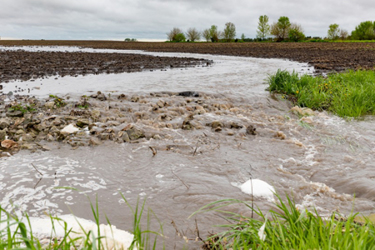Better Drinking Water Quality Starts Upstream


While every potable water treatment process requires a balance of chemistry and biology to deliver safe, clean drinking water, added concerns from upstream stormwater or agricultural runoff only make the job that much more difficult. How can we do a better job of safeguarding water treatment plant (WTP) operations while protecting the health of water utility customers against threats of upstream nonpoint source (NPS) pollution?
Point Source vs. Nonpoint Source Pollution
The U.S. EPA defines NPS pollution as “any source of water pollution that does not meet the legal definition of ‘point source’ in Section 502(14) of the Clean Water Act” (CWA). Points of concern around NPS pollution include: bacteria/nutrients from faulty septic systems, pet wastes, and stormwater runoff from residential lands or city streets; abandoned-mine drainage; eroding stream banks; and drainage from irrigated agriculture, agricultural stormwater discharges, and livestock operations not technically defined as concentrated animal feeding operations (CAFOs).
How Big Is The Problem?
The EPA states that, “Nonpoint source pollution (NPS) represents the most significant source of pollution overall in the country…more than 40 percent of all impaired waters were affected solely by nonpoint sources, while less than 10 percent of water quality criteria exceedances were caused by point-source discharges alone.”
Poorly managed stormwater runoff from both urban combined-sewer overflows (CSOs) and rural agricultural operations cause multiple downstream problems for drinking water intakes and for the environment as a whole. This National Association of Local Boards of Health report available from the Centers for Disease Control and Prevention (CDC) website provides good examples of concerns about livestock operations. Known areas of focus include North Carolina hog farms, Chesapeake Bay chicken farms, and Shenandoah River Valley animal feedlots. In addition to pathogen problems, NPS runoff can also generate nutrient loads that can exacerbate harmful algal blooms.
Looking Upstream For Answers: The Importance Of Field Monitoring
If forewarned is forearmed, upstream monitoring of known hotspots for NPS pollution is a good reactive strategy for protecting WTP surface-water intakes or compensating for undesirable conditions. Options can involve switching water sources in advance of an encroaching slug of contaminated runoff or adjusting the treatment train to deal with higher than normal concentrations of pollutants.
But a better long-term preventive strategy is to work continually to identify and resolve the root causes of NPS pollution as they grow in frequency and/or severity due to new commercial development, residential expansion, or changing weather and storm patterns. One resource to do that is to join the EPA’s NSPINFO discussion forum to share ideas from NSP experts in government, non-profit, municipal, academic, and technology organizations.
We’re All In This Together: Steps Toward NPS Pollution Reduction
Because dealing with NPS pollution often requires both public and private cooperative efforts, it pays to look for ways to encourage water-district residents, businesses, and governing bodies to join the effort. That could be as simple as communicating appropriate educational messages through regular utility communications channels or making concerted efforts to work with specific organizations associated with known watershed issues.
Local utilities can work through their state or regional NPS program contacts for guidance. They can also work with parties aligned with specific locations or applications that can contribute to NPS pollution — such as urban municipalities, residential areas, agricultural lands, abandoned mines, wetlands, and more. They can even join with other utilities to address NPS pollution on a watershed or estuary-wide basis — such as this specific EPA program on healthy watersheds.
- Homeowners. Use website and social media messaging, as well as publicity efforts and billing communications, to provide customers with regular reminders of steps they can take on their own properties to reduce NPS within the local watershed. These include:
- Good household maintenance practices such as low-phosphorus detergents and cleaners, septic system care, and picking up after pets to reduce the likelihood of stormwater runoff carrying nutrients and pathogens to the local water supply.
- Smart landscaping practices — e.g., minimal, well-managed fertilizer/chemical use, erosion-preventive landscaping, judicious use of wintertime de-icing agents, etc.
- Conscientious trash and chemical disposal efforts to minimize loose debris and recycle unused household and automotive chemicals/fuels to prevent them from reaching waterways.
- Agriculture. Collaborate with state and local agricultural departments and grower cooperatives to promote sound environmental practices that can impact a water utility’s local watershed. This can include encouraging participation in U.S. Department of Agriculture financial assistance programs such as Agricultural Management Assistance (AMA) and Environmental Quality Incentives Program (EQIP).
- Government Efforts. Work with federal, state, and local government entities and programs to promote sound environmental practices wherever possible. That can include industry-specific programs such as these construction-site erosion-control measures or this forestry program. Or it can encompass a variety of other EPA source-water protection programs, resources, and funding opportunities, as well as a multiple wastewater management programs.
- Environmental Groups. Maintain regular contact with groups active in specific environmental activities to piggyback off of their efforts. These might include watershed associations, source-water collaboratives, industrial-chemical cleanup programs, mine reclamation, or Clean Water Partnership (CWP) and federal CWA Section 319 programs.
Writing The Next Success Story
Finally, whatever the challenge or the partnership used to address it, take inspiration from the hundreds of success stories already being written about improving water bodies previously impaired by NPS pollution. Here are just a few of the many projects, large and small, that can provide insight and guidance:
- A $93-million selenium-removal project in California’s San Joaquin Basin and pesticide removal efforts in its Imperial Valley agricultural area.
- Agricultural best management practices that reduced selenium levels in Colorado’s South Platte River.
- Acid mine drainage treatments that improved water quality in Central Pennsylvania’s Swatara Creek.
- Erosion-control projects that reduced sediment, phosphorus, and manganese in the impaired waters of Illinois’ Charleston Side Channel Reservoir, a 346-acre public water-supply source.
